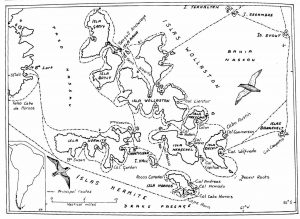FUEGIAN SNIPE EXPEDITION, CAPE HORN, CHILE: OVERVIEW
Our good friends Claudio Vidal and Enrique Couve at Far South Expeditions have managed to charter a yacht for us for a special Fuegian Snipe Quest in January 2020, to be guided by Enrique.
Fuegian Snipe is a rare, very little-known and barely accessible species that inhabits the small islands off the southernmost coastline of South America. Hardly any birders have ever seen one, and indeed most birders who are aware of its existence regard it as a ‘grail-bird’; one of those species that one dreams of, but never finds.
Our own Mark Beaman wrote about it and called it “A true bird of mystery: wanted by so many, observed by so few”.
Well, now you have the chance to participate in a Fuegian Snipe Expedition to the very best area for the species, where the highest density occurs; the remote islands of the Cape Horn archipelago.

During our expedition, which will have some scientific purpose as the primary intention is to survey the islands for snipe, we plan to explore Grevy, Bayly, Wollaston, Herschell and Hermite Islands, all of which can be seen on the above chart, and we may have time for more. Cape Horn, or Cabo de Hornos, island itself is a Chilean military outpost, but even so we may get permission to land.
The Fuegian Snipe is one of the least-known waders of Chile and the Neotropics. It has a stockier and heavier body than the migratory South American Snipe Gallinago paraguaiae, a summer resident in southern Patagonia. With its very long and broad-based bill, which it uses as a deep probe, the Fuegian Snipe feeds on invertebrates living in the peaty soil. It has noticeably thick legs, broad, very rounded wings, and, of course, the usual snipe-type, cryptically-coloured, plumage. There is individual variation, with some birds much darker or paler than average. It is believed to be most active at dusk, dawn and during the night, although in January there is no true darkness at these latitudes.
An endemic to southern Patagonia as mentioned above, it is rare, range-restricted and localized, confined to seldom-visited parts of the maritime, insular, western slope of the Andes, from sea level up to around 800m. It nests in the boggy tussock and other windswept Patagonian grasslands and flooded peat bogs of Sphagnum moss, close to the edge of evergreen forest of Magellan’s Southern Beech Nothofagus betuloides and Guaitecas Cypress Pilgerodendron uviferum.
It can be hard to spot if it does not move or flush. If threatened, it flies a short distance on fast wingbeats, following a straight course, to land nearby and scurry among the clumps of grass until it stops and sits still, making its detection difficult amidst the vegetation thanks to its highly criptic colours and patterns. It also sometimes perches on the roots of dwarf trees.
There are a few records in the non-breeding season to the north of Patagonia, which leads ornithologists to infer that part of the population may migrate, leaving the area during the coldest months. Its migrations, displacements, vocal behaviour and biology in general are still pretty well unknown and require far more research and study.
Our main quest is of course the Fuegian Snipe, but these remote islands have many other birds, most notably Magellanic Diving Petrel, Striated Caracara, White-throated Caracara and Blackish Cinclodes. There is also a fair chance for the uncommon Rufous-tailed Hawk.
Other bird species in the Cape Horn Islands include Magellanic and Southern Rockhopper Penguins, Upland, Kelp and Ashy-headed Geese, Flightless and Flying Steamer Ducks, Crested Duck, Chiloe Wigeon, Yellow-billed Teal, Yellow-billed Pintail, White-tufted and Great Grebes, Black-browed and Grey-headed Albatrosses, Southern Giant Petrel, Cape and White-chinned Petrels, Great and Sooty Shearwaters, Slender-billed Prion, Wilson’s Storm Petrel, Common Diving Petrel, Neotropic Cormorant, Rock Shag, Imperial Shag (including the ‘King Shag’ form), Black-crowned Night Heron, Black-faced Ibis, Andean Condor, Black-chested Buzzard-Eagle, Chilean and Variable Hawks, Southern and Chimango Caracaras, American Kestrel, Peregrine Falcon, Plumbeous Rail, Blackish and Magellanic Oystercatchers, Two-banded Plover, Rufous-chested Dotterel, South American Snipe, White-rumped and Baird’s Sandpipers, Snowy Sheathbill, Chilean Skua, Dolphin, Kelp and Brown-hooded Gulls, South American Tern, Eared Dove, Austral Parakeet, Magellanic Horned Owl, Ringed Kingfisher, Dark-bellied, Grey-flanked and Buff-winged Cinclodes, Thorn-tailed Rayadito, White-throated Treerunner, Magellanic Tapaculo, Chilean Elaenia, Tufted Tit-Tyrant, Fire-eyed Diucon, Dark-faced and Ochre-naped Ground Tyrants, Austral Negrito, Chilean and Barn Swallows, House and Grass Wrens, Austral Thrush, Patagonian Sierra Finch, Rufous-collared Sparrow, Long-tailed Meadowlark, Austral Blackbird and Black-chinned Siskin.
On Isla Navarino there are also Black-necked Swan, Bronze-winged (or Spectacled) Duck, Western Cattle Egret, Southern Lapwing, Western Barn, Rufous-legged and Austral Pygmy Owls, Green-backed Firecrown, Magellanic Woodpecker, Patagonian Tyrant, Grey-hooded Sierra Finch, Yellow-bridled Finch and the introduced House Sparrow.
Accommodation: We use a comfortable hotel in Puerto Williams. We will be staying and travelling between islands on the yacht M/Y Chonos. She is 17 metres (56 feet) in length and has two passenger cabins. There are two bathrooms. There will be plenty of food and a good atmosphere on board. This may be a real expedition, but it will also be fun.
Walking: There are few paths on these uninhabited islands and the terrain is often boggy and/or undulating, so the walking effort will be moderate. If you want to look for White-bellied Seedsnipe out of Puerto Williams you need to be reasonably fit as the walk up to the site is fairly demanding.
Climate: Isla Navarino and Cape Horn is an ‘edge of the known world’ kind of place, often windy, with changeable weather: sunny spells change to rain and overcast, and back again, often in short order. It is cool even in January, which passes for early summer in these parts.
Bird Photography: Opportunities will be quite good.







